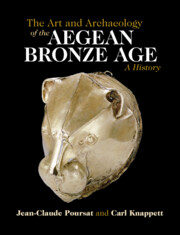Book contents
- The Art and Archaeology of the Aegean Bronze Age
- The Art and Archaeology of the Aegean Bronze Age
- Copyright page
- Contents
- Figures
- Introduction
- Part I Aegean Neolithic Art
- Part II The Art of the Aegean Early Bronze Age
- Part III Aegean Art in the Cretan First Palace Period
- Part IV Aegean Art in the Second Palace Period
- Part V Aegean Art in the Cretan Second Palace Period
- Chapter 26 Artworks in Context
- Chapter 27 Funerary Architecture
- Chapter 28 Metalwork
- Chapter 29 Creto-Mycenaean Glyptic
- Chapter 30 Other Mycenaean Relief Arts
- Chapter 31 Mycenaean Pottery of LH I–IIA
- Chapter 32 General Remarks
- Part VI Aegean Art in the Final Palatial Period of Knossos
- Part VII Aegean Art of the Mainland Mycenaean Palatial Period
- Part VIII Aegean Art at the End of the Bronze Age
- Afterword Aegean Art Through Forgers’ Eyes
- References
- Index
- Plate Section (PDF Only)
- References
Chapter 27 - Funerary Architecture
from Part V - Aegean Art in the Cretan Second Palace Period
Published online by Cambridge University Press: 19 May 2022
- The Art and Archaeology of the Aegean Bronze Age
- The Art and Archaeology of the Aegean Bronze Age
- Copyright page
- Contents
- Figures
- Introduction
- Part I Aegean Neolithic Art
- Part II The Art of the Aegean Early Bronze Age
- Part III Aegean Art in the Cretan First Palace Period
- Part IV Aegean Art in the Second Palace Period
- Part V Aegean Art in the Cretan Second Palace Period
- Chapter 26 Artworks in Context
- Chapter 27 Funerary Architecture
- Chapter 28 Metalwork
- Chapter 29 Creto-Mycenaean Glyptic
- Chapter 30 Other Mycenaean Relief Arts
- Chapter 31 Mycenaean Pottery of LH I–IIA
- Chapter 32 General Remarks
- Part VI Aegean Art in the Final Palatial Period of Knossos
- Part VII Aegean Art of the Mainland Mycenaean Palatial Period
- Part VIII Aegean Art at the End of the Bronze Age
- Afterword Aegean Art Through Forgers’ Eyes
- References
- Index
- Plate Section (PDF Only)
- References
Summary
Unlike crete and the cyclades during the Neopalatial period, where palaces, grand villas, and towns offer a picture of intense and innovative activity, Helladic architecture remains poorly known – with the exception of burial monuments. Only a handful of settlements have been investigated, and these only partially (Darcque 2005, 395). On the Aspis hill at Argos, a position that controls the valley, buildings from the Middle Helladic (MH)/Late Helladic (LH) transition result in a rudimentary urban plan; a row of tripartite houses run along part of the hill (N. Papadimitriou et al., in Schallin and Tournavitou 2015, 163–84). Kolonna (Aegina) is a special case; much like Cycladic towns, the fortified town is extended at the very end of the MH period (W. Wohlmayr, in Felten 2007, 45–55), but it is not until the second half of the fifteenth century bc that the first substantial buildings appear.
- Type
- Chapter
- Information
- The Art and Archaeology of the Aegean Bronze AgeA History, pp. 271 - 281Publisher: Cambridge University PressPrint publication year: 2022

